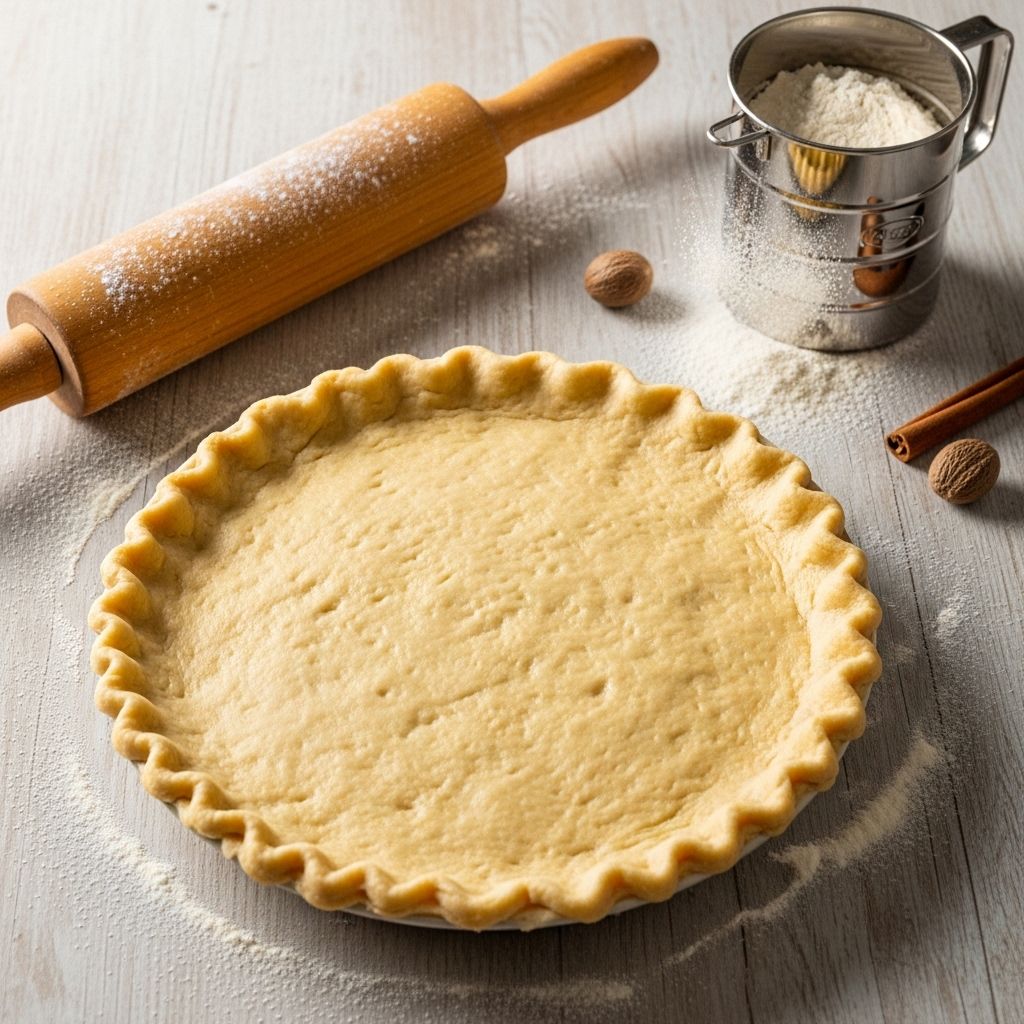Mastering Easy Pie Dough: Step-by-Step Guide to Foolproof Flaky Crust
The cold-butter method yields delicate pastry that separates into crisp, buttery bites.

Easy Pie Dough: The Easiest Path to Flaky, Tender Pie Crust
Making homemade pie dough is often perceived as daunting by bakers new and experienced alike. This guide demystifies pie dough, presenting a simple, reliable method that consistently delivers tender, flaky results without fuss. Using a food processor and basic pantry ingredients, you’ll master pie dough and expand your pie-making repertoire with confidence.
Why Choose This Easy Pie Dough Recipe?
- Effortless Mixing: Minimal handling, less chance for tough crust.
- Consistent Flakiness: Butter stays cold, creating distinct layers as it bakes.
- Reliable Outcome: Science-backed technique reduces guesswork.
- Versatile Uses: Suitable for sweet and savory pies, tarts, or galettes.
Ingredients & Tools You’ll Need
| Ingredient | Quantity | Notes |
|---|---|---|
| All-purpose flour | 2 1/2 cups | Divided |
| Granulated sugar | 2 tablespoons | Optional, for slight sweetness |
| Kosher salt | 1 teaspoon | Enhances flavor |
| Unsalted butter | 2 1/2 sticks (20 tablespoons, 10oz) | Very cold, cut into 1/4-inch slices |
| Cold water | 6 tablespoons | Ice water preferred |
- Food Processor: Cuts mixing time and improves consistency.
- Plastic wrap: For chilling dough.
- Rolling pin: For rolling out chilled dough.
Step-by-Step Instructions for Foolproof Easy Pie Dough
1. Combine Dry Ingredients
Place 1¾ cups of flour, sugar, and salt into the bowl of a food processor. Pulse briefly 2–3 times to evenly combine.
2. Add Butter for Flakiness
Scatter cold butter slices over the flour mixture. Use short, quick pulses (about 25–50 times, depending on your food processor) until the dough begins to form small clumps and no dry flour remains. The mixture should resemble coarse meal with visible pea-sized butter bits.
3. Final Flour Addition
Add the remaining ¾ cup flour. Pulse a few times until mixture is just broken up and distributed – do not overmix.
4. Hydrate With Water
Transfer dough to a large mixing bowl. Sprinkle cold water over the surface. Fold and press with a rubber spatula until the dough gathers into a ball. Be gentle to avoid overworking.
5. Divide and Chill
Divide dough into two even pieces. Shape each into a disk about 1 inch thick. Wrap tightly with plastic wrap and refrigerate for at least 2 hours, or up to overnight. Chilling is crucial for texture and ease of rolling.
Tips for Pie Dough Success
- Keep Everything Cold: Chill butter, water, and even the flour if your kitchen is warm. Cold fat creates flaky pockets.
- Pulse, Don’t Process: Use short pulses in the food processor to maintain control and prevent overmixing.
- Hydration Matters: Add water gradually. Too much water makes dough sticky; too little keeps it crumbly. Look for dough that just holds together, not wet or dry.
- Let Dough Rest: Chilling relaxes gluten, minimizing shrinkage, and makes rolling easier.
The Science Behind Flaky Pie Dough
The key to flaky crust is solid pieces of fat—in this recipe, cold butter—dispersed in the flour. As the pie bakes, water in butter steams, expanding trapped layers and separating them, yielding the signature flakes. Proper technique ensures butter remains in distinct bits rather than fully blended.
Food Processor Method vs. Traditional Hand Mixing
| Method | Advantages | Potential Pitfalls |
|---|---|---|
| Food Processor | Quick, even mixing; reduces handling; more reliable flake | Easy to overmix, resulting in tough dough |
| Hand Mixing | Tactile control; traditional; less risk of overmixing | More variable results; requires practice |
Rolling Out and Using Your Pie Dough
- Remove dough from fridge and let it rest on the counter until slightly pliable for easier rolling.
- Lightly flour your work surface and rolling pin.
- Roll gently from the center outward, rotating the dough periodically for even thickness.
- For double-crust pies, roll each disk separately.
- Carefully transfer rolled dough into your pie dish, easing it gently to avoid stretching (stretching causes shrinkage during baking).
- Trim excess and crimp edges as desired.
Pie Dough Variations & Adaptations
- Savory Crust: Omit sugar, add herbs or cracked pepper to flour for quiches or pot pies.
- Whole Wheat Option: Substitute half the flour with whole wheat for hearty flavor.
- Lard or Shortening: Replace part or all of the butter for different textures—lard is extra flaky, shortening makes tender dough.
- Egg Yolks for Richness: Add 1–2 egg yolks for a more tender, richer crust.
Troubleshooting Common Pie Dough Problems
- Dough is Too Dry and Won’t Come Together: Sprinkle more cold water, 1 teaspoon at a time, mixing gently.
- Dough is Sticky: Sprinkle with additional flour when rolling; chill longer if needed.
- Dough Tears When Rolling: Let dough sit at room temperature for a few extra minutes to soften slightly.
- Crust Shrinks During Baking: Ensure adequate rest/chill time; avoid stretching dough into the pan.
Pie Dough FAQ
How long can I refrigerate pie dough?
Pie dough can be stored in the refrigerator for up to 5 days, tightly wrapped. For longer storage, freeze the disks for up to 3 months and thaw overnight in the fridge before using.
Why is cold butter important for pie crust?
Cold butter creates steam as it melts while baking, forming flaky layers. Warm butter gets absorbed by flour, reducing flakiness.
Can I make pie dough without a food processor?
Yes. Use a pastry blender or two knives to cut butter into flour until pea-sized crumbs form. Hand mixing offers more control but requires careful technique to avoid melting the butter.
My dough is tough after baking. What went wrong?
Overmixing the dough or adding too much water can activate gluten, making the crust chewy and less flaky. Mix only until dough comes together.
Should I pre-bake (blind bake) the crust?
Blind baking is recommended for liquid or custard fillings to maintain crispness. Line the crust with parchment and fill with pie weights, bake at 375°F until edges are golden, then remove weights and bake further if needed.
Serving, Storing, and Reheating Pie
- Allow baked pies to cool fully for texture and sliceability.
- Store pies covered at room temperature (for fruit pies) or refrigerated (for custard, cream pies).
- To reheat: bake in a 325°F oven for 10–15 minutes, loosely tented with foil to preserve flakiness.
Recommended Pies to Try With This Dough
- Classic apple pie
- Pumpkin pie
- Pecan or chocolate tart
- Quiche or savory galette
- Berry lattice pie
Expert Pie Dough Tips for Perfect Results
- Use a marble or metal rolling pin—stays colder longer.
- Knead dough as little as possible.
- Chill dough before handling and again after lining the pan.
- Let butter get just warm enough to roll—too cold and dough cracks, too soft and dough sticks.
Easy Pie Dough Recipe Card
- 2½ cups all-purpose flour, divided
- 2 tablespoons sugar (omit for savory pies)
- 1 teaspoon kosher salt
- 2½ sticks (10oz) unsalted butter, cold, cut into ¼-inch slices
- 6 tablespoons cold water
- Blend 1¾ cups flour, sugar, and salt in food processor. Pulse.
- Add cold butter, pulse until clumpy, about 25–50 pulses.
- Add remaining ¾ cup flour. Pulse a few times.
- Transfer to bowl, add water, gently mix until dough forms.
- Divide, shape into disks, wrap, and chill 2 hours before rolling.
Frequently Asked Questions (FAQs)
Q: Can I freeze pie dough?
A: Yes, wrap tightly in plastic and store in a freezer bag for up to 3 months. Thaw overnight in the refrigerator before using.
Q: Can I roll out the dough right after mixing?
A: No, chilling prevents shrinkage, tough crust, and sticking. Minimum 2 hours recommended.
Q: Should I add vinegar or alcohol to my pie dough?
A: A small splash of vinegar or vodka can help reduce gluten formation, but is optional and not required for success.
Q: How can I tell if the dough is ready during mixing?
A: Dough should just hold together when pressed between fingers. If it crumbles, add more water. If sticky, add flour.
Conclusion: Demystify Your Bake
Pie dough need not be intimidating—this easy, step-by-step method prioritizes cold butter, gentle mixing, and strategic rest times to yield reliably flaky, tender crusts. Whether you’re baking sweet or savory pies, mastering this technique unlocks both consistent results and creative freedom. Begin with the simple formula here, and explore pie possibilities from fruit-filled to custardy or inventive savory creations. Happy baking!
Read full bio of Anjali Sayee












